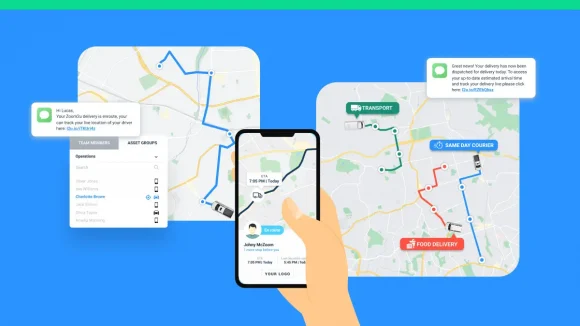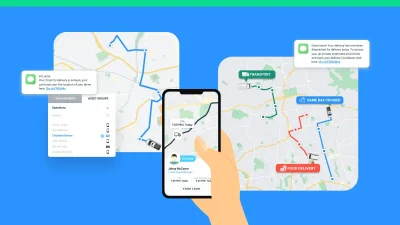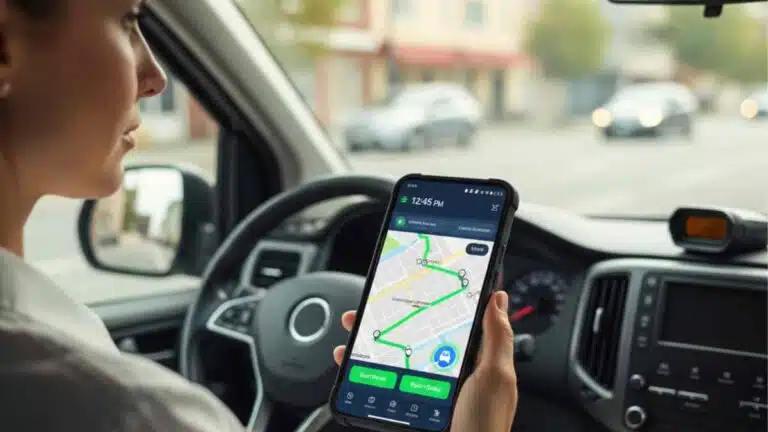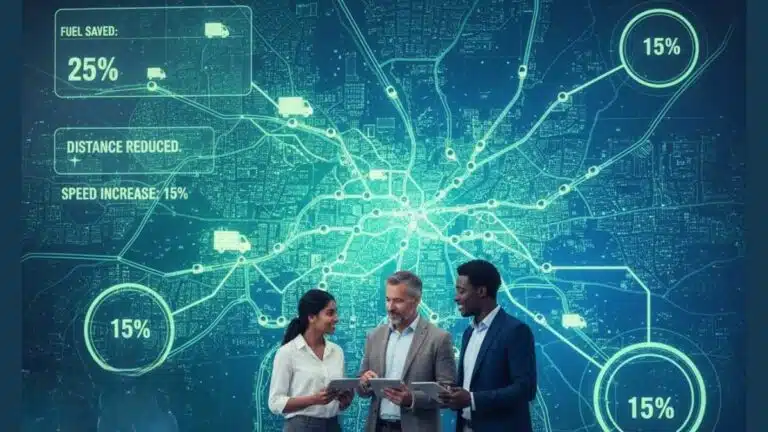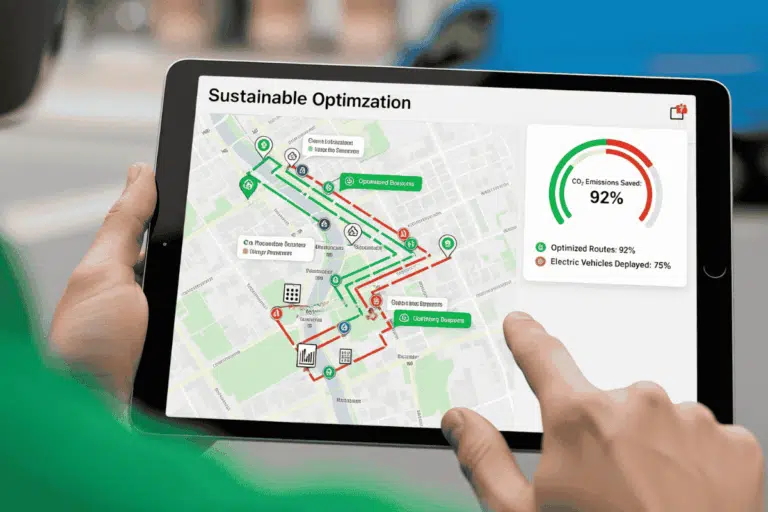In today’s fast-paced world, delivery businesses need to operate with the utmost efficiency and accuracy. This is where delivery route planning and optimization come into play. The most efficient route can make all the difference in ensuring that deliveries are made on time and at the lowest possible cost. With the advent of route planning software, businesses can now plan delivery routes more efficiently than ever before.
Delivery route planning software enables businesses to streamline the route planning process and optimize their delivery routes. By analyzing traffic patterns, delivery frequency, driver availability, and delivery priorities, businesses can plan the most efficient route possible. With delivery route planning software, businesses can reduce unnecessary stops, minimize left turns, and group deliveries by location, among other strategies.
The route planning and optimization process is essential for businesses that rely on efficient delivery routes. By utilizing delivery route planning software, businesses can reduce costs, increase productivity, and improve customer satisfaction. In this guide, we will explore the various factors that go into optimizing delivery routes, the tools available for route mapping and optimization, and tips for implementing and refining optimized delivery routes. Let’s dive in and explore the world of delivery route planning and optimization.

The Ultimate Guide to Delivery Route Planning
Keep reading our ultimate guide to optimizing your delivery routes so you can take your small business to the next level!
Analyzing Current Delivery Routes
The significance of reviewing present routes
For your delivery operations to be optimized, it is essential to analyze your current delivery routes. You can do this to find inefficiencies, cut expenses, and boost overall effectiveness and customer happiness. It enables you to assess the success of your present route planning method and make the required modifications to enhance your delivery procedure.
Data gathering techniques
You must gather information about your current routes in order to examine your delivery routes. Several methods, including manual data collection, GPS tracking, and delivery management software, are available for doing this. Using spreadsheets or paper records, manual data gathering involves monitoring driver activity, delivery schedules, and routes. GPS tracking follows the movements of drivers and deliveries using real-time location data. Data can be automatically gathered and analyzed by delivery management software, giving you real-time insights into your delivery operations.
Making a list of inefficiencies
After gathering information on your present delivery routes, you can spot inefficiencies that are having an effect on your business. Long delivery delays, expensive gasoline, driver inefficiency, or road congestion are examples of inefficiencies. You can create plans to enhance your delivery operations and optimize your routes by identifying these inefficiencies.
In general, the first step in streamlining your delivery operations is to analyze your present delivery routes. You can find inefficiencies and create plans to streamline your delivery process by gathering and evaluating data on your current routes. This may result in increased productivity, lower expenses, and happier customers.

Things to Take Into Account When Optimizing Delivery Routes
Congestion and traffic flow
Delivery timings and route planning can be significantly impacted by traffic patterns and congestion. In order to prevent delays and guarantee on-time deliveries, it is crucial to take traffic patterns and congestion into account when optimizing delivery routes. The most effective routes can be found by analyzing traffic patterns using mapping software and GPS tracking.
Calculations of distance and time
Estimates of time and distance are essential for planning delivery routes. You may create effective routes and guarantee on-time deliveries with the aid of accurate estimations. The distance between delivery locations and the anticipated time needed to accomplish each delivery should be taken into account. Accurate distance and time estimations can be made using mapping software and GPS tracking.
Regularity of delivery
Another crucial aspect to take into account when optimizing delivery routes is delivery frequency. Planning your routes should take into account how frequently deliveries are made to each site. Organizing delivery according to location helps speed up operations and cut down on travel time.
Schedules and the availability of drivers
When maximizing delivery routes, schedules and driver availability should also be taken into account. Each driver’s availability should be taken into account, and routes should be realistic given their schedules. Make sure that routes are not overly difficult and that drivers have enough time to finish each delivery.
Delivery deadlines and priorities
When maximizing delivery routes, it’s important to take delivery priorities and time windows into account as well. Prioritize deliveries that must be made on time and arrange your routes so that they may be made within predetermined time frames. This can lower the possibility of missed delivery while also improving client satisfaction.
In general, it’s crucial to take into account aspects like traffic patterns, distance and time estimations, frequency of deliveries, driver availability and schedules, and delivery priority and time slots while optimizing delivery routes. You may create effective routes that serve the interests of both your clients and your company by taking these variables into account.
Considerations for Optimising Delivery Routes
Congestion and traffic flow
Congestion and traffic patterns must be taken into consideration when determining the best delivery routes. You can create more effective routes and prevent delays by having a thorough understanding of the traffic patterns and congestion in the locations you serve. Peak traffic hours, construction zones, and other variables that may affect travel time should be taken into account. Based on current traffic data, you can determine the most effective routes by using mapping tools and GPS monitoring.
Calculations of distance and time
When maximizing delivery routes, accurate distance and time estimates are also crucial considerations. You can create routes that are effective and attainable by evaluating the distance between delivery locations and the amount of time needed to complete each delivery. Accurate distance and time estimations may be determined using mapping software and GPS tracking, which can help you streamline your delivery process and raise customer satisfaction.
Regularity of delivery
Another crucial aspect to take into account when optimizing delivery routes is delivery frequency. Organizing delivery according to location helps speed up operations and cut down on travel time. The frequency of delivery to each place should also be considered while planning routes. You can make sure that you are delivering to each place as quickly as possible and minimizing needless travel by doing this.
Schedules and the availability of drivers
Driver availability and timetables are key considerations when optimizing delivery routes. Each driver’s availability should be taken into account, and routes should be realistic given their schedules. Make sure that routes are not overly difficult and that drivers have enough time to finish each delivery. You can increase driver satisfaction and lower the likelihood of driving weariness by doing this.
Delivery deadlines and priorities
When maximizing delivery routes, it’s important to take delivery priorities and time windows into account as well. Prioritize deliveries that must be made on time and arrange your routes so that they may be made within predetermined time frames. By doing this, you can improve client satisfaction and lower the possibility of delivery being missed. Additionally, when planning routes, take each customer’s delivery priorities into account.
Overall, it’s crucial to take traffic patterns, distance and time estimations, delivery frequency, driver availability and schedules, delivery priority and time frames, and other elements into account while optimizing delivery routes. You may create effective routes that satisfy both your consumers’ and your company’s needs by taking into account these variables. This may result in greater effectiveness, lower costs, and higher customer satisfaction.

Tools for mapping and routing
A description of mapping and routing software
Tools for routing and mapping are crucial for streamlining delivery routes. To assist you in planning the most effective routes, these tools make use of mapping technology and current data. They can assist you in time savings, cost savings, and increased client satisfaction.
Delivery management software is a comprehensive platform for managing deliveries, including planning routes, tracking deliveries, and managing drivers. It can play a crucial role in route optimization by automating the delivery process and optimizing routes based on various factors such as distance, time, and customer preferences.
One example of delivery management software is Locate2u, which provides route optimization and live-tracking features. It can help businesses save time and money by optimizing routes and reducing delivery times.
Businesses can improve productivity, increase customer happiness, and streamline their delivery processes by employing delivery management software.
Advice on Improving Delivery Routes
Sorting delivery based on place
Grouping deliveries by location is one of the best techniques to optimize delivery routes. You can cut down on travel time and fuel expenses by making deliveries to several customers in one location. To accomplish this, create delivery zones and schedule deliveries for the same day in each zone.
Giving urgent deliveries top priority
Prioritize time-sensitive deliveries like perishable food, medical supplies, or urgent packages to make sure they get there on time. This can be achieved by giving certain deliveries a higher priority when determining the routes and making sure they are delivered ahead of other non-time-sensitive deliveries.
Using turn-by-turn navigation
Giving drivers turn-by-turn directions can make it easier for them to follow the delivery path. Software for delivery management or mapping tools can be used to do this. By giving drivers precise and succinct instructions, you may help them avoid getting lost or making unnecessary stops, which will save them time and money on fuel.
Taking fewer left turns
Cutting back on left turns can help you save time and money on fuel. Left turns frequently necessitate waiting for oncoming traffic, which can lead to delays and raise the possibility of collisions. Drivers can make deliveries more quickly and safely by limiting left turns.
Minimizing pointless stops
Reducing idling can help you save time and money on fuel. Consolidating deliveries, eliminating detours, and minimizing unnecessary stops can all help with this. Drivers can complete more deliveries in less time and with less fuel by cutting back on unnecessary stops.
Considering alternative modes of transportation
Alternative forms of transportation such as bicycles, motorbikes, or electric cars can be considered for longer distances or heavier deliveries. These modes of transportation may be more fuel-efficient, less harmful to the environment, and simpler to use in congested areas.
By implementing these recommendations, businesses can improve their delivery routes, save time, and money on petrol, and boost customer satisfaction.
Examining and enhancing delivery routes
The value of route testing and optimization
By regularly testing and optimizing delivery routes, businesses can enhance their delivery process and reduce costs. Monitoring and analyzing delivery data on a regular basis can help businesses identify inefficiencies and change their routes.
Monitoring and studying data
Businesses should monitor and analyze delivery data in order to optimize delivery routes. This can include things like delivery windows, client locations, driver schedules, and other pertinent information. Businesses might find patterns and inefficiencies in their distribution process by examining this data.
Making modifications in light of data analysis
Businesses might alter their delivery routes based on the data analysis. To increase efficiency, this may entail altering delivery timetables, rerouting deliveries, or shifting the sequence of deliveries.
How testing and route optimization can be aided by delivery management software
By giving real-time information on delivery performance, delivery management software can help with testing and fine-tuning delivery routes. To find inefficiencies and modify delivery routes, this data might be used. Advanced routing algorithms that may optimize routes depending on several criteria, such as traffic patterns, delivery schedules, and client preferences, can also be provided via delivery management software.
In order to optimize the delivery process and cut expenses, delivery routes must be tested and improved. Businesses can find inefficiencies and alter their delivery routes by monitoring and analyzing delivery data. Real-time data and sophisticated routing algorithms are provided by delivery management software, which can help with this procedure.
Application and Training
Using route optimization
Businesses must integrate the optimal delivery routes into their delivery process when they have been determined. This may entail revising delivery schedules, informing clients of modifications to delivery times, and working with drivers to make sure they are informed of the modified routes.
Educating truckers about new routes
Businesses must offer training on the optimized routes to ensure that drivers can use the new routes safely. Turn-by-turn directions, identifying significant landmarks and sites of interest along the routes, and instructions on how to use delivery management software and mapping tools are a few examples of how to do this.
Monitoring and making necessary adjustments
Even with optimum delivery routes, there may still be unforeseen events or delays that need route revisions. To guarantee that deliveries are made effectively, businesses should routinely review delivery performance and modify routes as necessary.
How delivery management software can help with setup and instruction
By giving drivers real-time information on delivery routes, including turn-by-turn directions and real-time traffic updates, delivery management software can help with deployment and training. This can make drivers’ route-finding more effective and guarantee on-time delivery. Additionally, delivery management software can offer drivers tutorials and videos on how to use its mapping features as well as other training materials.
To ensure that deliveries are made effectively and on schedule, it is crucial to implement and train drivers on improved delivery routes. By offering drivers training materials and real-time information, delivery management software can help with this process.

Advantages of Delivery Management and Route Optimization Software
Enhanced productivity and efficiency
Software for managing deliveries and optimizing routes can greatly improve the effectiveness and productivity of deliveries. Drivers may make more deliveries in less time by streamlining their routes and eliminating pointless stops. Increased production and income for the company may result from this.
Lower costs
Businesses can lower labor expenses, fuel costs, and maintenance costs related to the delivery process by optimizing delivery routes. By automating delivery scheduling, tracking, and reporting, delivery management software can help lower administrative costs.
Enhanced client satisfaction
Software for delivery management and route optimization can increase customer satisfaction by giving more precise delivery estimates and lowering delivery faults. Customers can stay updated on the progress of their deliveries and make any necessary schedule changes thanks to real-time tracking and delivery updates.
Enhanced driver satisfaction and safety
Because it offers real-time traffic updates and turn-by-turn directions, delivery management software can increase driver safety. Delivery management software can lower the risk of accidents and increase driver safety by limiting left turns and unnecessary stops. Increased retention and driver satisfaction may result from this.
In general, route optimization and delivery management software can offer businesses a number of advantages, such as better effectiveness and productivity, cost savings, more customer happiness, and improved driver safety and satisfaction.

Optimize every delivery route with Locate2u
Delivery route optimization is a crucial component of any delivery business. By utilizing delivery route planning software, businesses can streamline their route planning process and optimize their delivery routes for maximum efficiency and cost-effectiveness. With the ability to plan multiple and multi-stop routes, delivery drivers can complete more deliveries in less time, leading to increased productivity and revenue.
Locate2u is a leading provider of delivery route optimization software, designed specifically for businesses that rely on efficient delivery routes. With Locate2u, businesses can optimize their routes, reduce delivery times, and improve customer satisfaction. The software allows businesses to plan multiple routes with turn-by-turn directions, real-time traffic updates, and delivery tracking. This enables delivery drivers to make more deliveries in less time, while also improving their safety and job satisfaction.
Delivery route optimization is critical for businesses that rely on efficient and cost-effective delivery routes. By utilizing delivery route planning software such as Locate2u, businesses can optimize their routes, reduce costs, and improve customer satisfaction.
If you are a delivery business looking to streamline your delivery routes and improve your bottom line, consider investing in our delivery route optimization software today.

